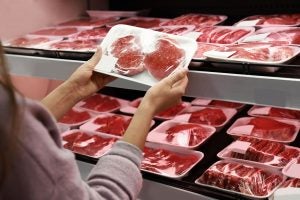Fear-based marketing is almost always bad. It’s a marketing strategy that appeals to consumers’ fears and anxieties in order to motivate them to take a specific action. While effective in the short term, it can cause negative consequences for both consumers and businesses. That’s because it taps into our basic survival instincts. When we’re afraid, we’re more likely to take a certain action to protect ourselves from harm.
Over the years, I’ve provided lots of examples, and shown how these strategies harm farmers, consumers, and the environment. But lately it seems that some farmers are employing these same fear-based tactics to sell their products.
I’ve seen several social media posts from direct-to-consumer beef producers showing photos of their product purportedly next to store-bought beef. The photos highlight color or other visual differences. The poster posits that these differences have to do with the quality and nutrition of the meat — and suggests consumers need to purchase beef directly from the producer to benefit their families.
I don’t have a problem with people buying local meat directly from farmers and ranchers. Sometimes it’s more economical, it tastes better, and it supports a neighbor or friend. My family has made the same choice for all of those reasons (and, moment of truth, it wasn’t all superior to the grocery store). And I’m happy farmers have markets like this for their products, especially if they can earn more this way.
But drumming up business is no justification for scaring people about food sold in the local grocery store.

Let’s clear the air: Meat bought in the grocery store is high quality, nutritious, and safe. No one should feel bad about purchasing beef from a retailer and feeding it to their families. If that’s you, don’t let this messaging make you feel bad.
Why does the color of meat vary? The answer is myoglobin. Myoglobin is a protein residing within muscle cells. Its natural state is a purplish hue. But when it encounters oxygen, it transforms into oxymyoglobin, a vibrant red pigment that gives meat its characteristic color. The amount of oxygen available also plays a role, as well as storage time and temperature. So meat will naturally — and safely — turn from a purple-red color to bright red, and then brown.

Other factors also play a role. These include age of the animal, sex of the animal, and how much exercise the animal got during its life. For example, older animals usually have darker meat because myoglobin levels increase with age. More relevant here, an animal’s diet can also influence the color of meat. Grass has higher levels of antioxidants than grains. So grass-fed beef may appear darker.
So it’s entirely possible and plausible that meat purchased at a local farm will look a little different from meat at the grocery store. But that difference doesn’t have much, if anything, to do with quality or nutrition.
Farmers, let’s not embrace the tactics of radical environmental groups to sell our products. With the rising cost of food and inflation, families need options, not anxiety. Good, quality products will sell themselves; they don’t need fear to stand out. We can do better.
Amanda Zaluckyj blogs under the name The Farmer’s Daughter USA. Her goal is to promote farmers and tackle the misinformation swirling around the U.S. food industry.



